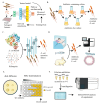Recent Advances in Antimicrobial Resistance: Insights from Escherichia coli as a Model Organism
- PMID: 39858819
- PMCID: PMC11767524
- DOI: 10.3390/microorganisms13010051
Recent Advances in Antimicrobial Resistance: Insights from Escherichia coli as a Model Organism
Abstract
Antimicrobial resistance (AMR) represents a critical global health threat, and a thorough understanding of resistance mechanisms in Escherichia coli is needed to guide effective treatment interventions. This review explores recent advances for investigating AMR in E. coli, including machine learning for resistance pattern analysis, laboratory evolution to generate resistant mutants, mutant library construction, and genome sequencing for in-depth characterization. Key resistance mechanisms are discussed, including drug inactivation, target modification, altered transport, and metabolic adaptation. Additionally, we highlight strategies to mitigate the spread of AMR, such as dynamic resistance monitoring, innovative therapies like phage therapy and CRISPR-Cas technology, and tighter regulation of antibiotic use in animal production systems. This review provides actionable insights into E. coli resistance mechanisms and identifies promising directions for future antibiotic development and AMR management.
Keywords: AMR prevention; Escherichia coli; antimicrobial resistance; machine learning; synthetic biology.
Conflict of interest statement
The authors declare no conflicts of interest.
Figures


Similar articles
-
Genome-Scale Metabolic Models and Machine Learning Reveal Genetic Determinants of Antibiotic Resistance in Escherichia coli and Unravel the Underlying Metabolic Adaptation Mechanisms.mSystems. 2021 Aug 31;6(4):e0091320. doi: 10.1128/mSystems.00913-20. Epub 2021 Aug 3. mSystems. 2021. PMID: 34342537 Free PMC article.
-
Emerging threats: Antimicrobial resistance in extended-spectrum beta-lactamase and carbapenem-resistant Escherichia coli.Microb Pathog. 2025 Mar;200:107275. doi: 10.1016/j.micpath.2024.107275. Epub 2025 Jan 9. Microb Pathog. 2025. PMID: 39798725 Review.
-
Unlocking Nitrofurantoin: Understanding Molecular Mechanisms of Action and Resistance in Enterobacterales.Med Princ Pract. 2025;34(2):121-137. doi: 10.1159/000542330. Epub 2024 Oct 29. Med Princ Pract. 2025. PMID: 39471786 Free PMC article. Review.
-
Large-Scale Studies on Antimicrobial Resistance and Molecular Characterization of Escherichia coli from Food Animals in Developed Areas of Eastern China.Microbiol Spectr. 2022 Aug 31;10(4):e0201522. doi: 10.1128/spectrum.02015-22. Epub 2022 Aug 11. Microbiol Spectr. 2022. PMID: 35950758 Free PMC article.
-
Genomic Insights into the Mobilome and Resistome of Sentinel Microorganisms Originating from Farms of Two Different Swine Production Systems.Microbiol Spectr. 2022 Dec 21;10(6):e0289622. doi: 10.1128/spectrum.02896-22. Epub 2022 Nov 15. Microbiol Spectr. 2022. PMID: 36377950 Free PMC article.
Cited by
-
Six-year antimicrobial resistance patterns of Escherichia coli isolates from different hospitals in Gaza, Palestine.BMC Microbiol. 2025 Aug 29;25(1):559. doi: 10.1186/s12866-025-04335-3. BMC Microbiol. 2025. PMID: 40883683 Free PMC article.
References
-
- Xiao R., Li Y., Liu X., Ding Y., Lai J., Li Y., Kang W., Zou P., Wang J., Du Y., et al. Antibiotic susceptibility of Escherichia coli isolated from neonates admitted to neonatal intensive care units across China from 2015 to 2020. Front. Cell. Infect. Microbiol. 2023;13:1183736. doi: 10.3389/fcimb.2023.1183736. - DOI - PMC - PubMed
Publication types
Grants and funding
LinkOut - more resources
Full Text Sources

